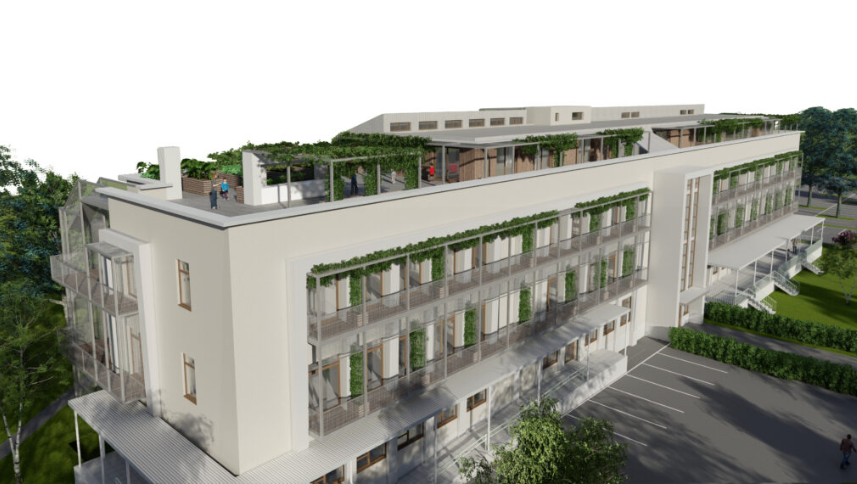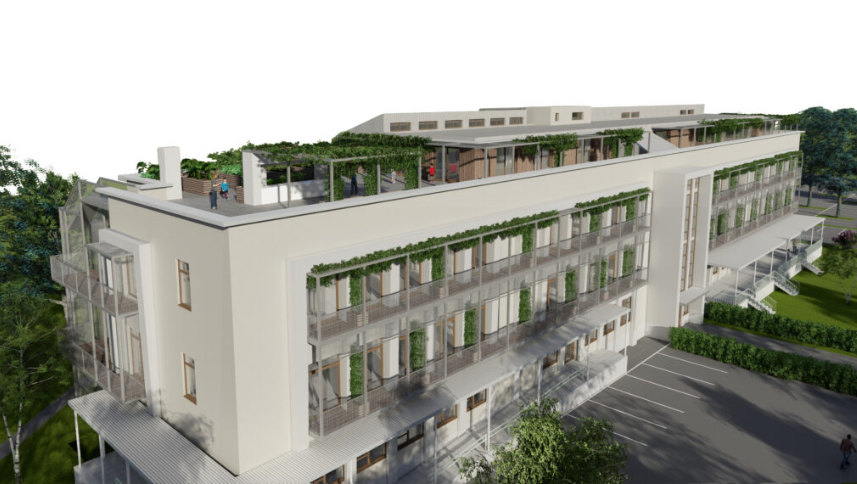Co-operative housing project in Croatia: the case of the city of Križevci
Created on 05-09-2024 | Updated on 15-11-2024
Housing affordability is interpreted and measured in different ways, with the EU generally using the relationship between price and income as the main indicator. The affordability of housing is influenced by local housing prices, income levels and interest rates. In Croatia, housing affordability problems exist in both urban and rural areas due to low incomes and high energy inefficiency of houses, particularly for homeowners in the rural areas. Low interest rates have boosted investment in property, driving up prices and contributing to market speculation, especially in tourist areas. The financialization of housing and foreign investment further exacerbate the affordability problem. To overcome these challenges, collaborative housing models, including co-housing and co-operatives, offer potential solutions. These models emphasise user participation, mutual respect and solidarity, often financed through crowdfunding. Housing cooperatives, where members share ownership and control, prevent market speculation and maintain long-term affordability. Croatia is testing this approach through pilot projects, such as in Križevci, which aims to create a framework for cooperative housing. The project involves the conversion of a former military facility into cooperative housing and is supported by the local government and various organisations. This initiative underlines the potential of cooperative housing to provide sustainable, community-oriented solutions to Croatia's overheated housing market.
Instrument
regulation, incentive
Issued (year)
2021
Application period (years)
2021-2023
Scope
local
Target group
young, first-time buyers, elderly
Housing tenure
co-operative housing
Discipline
economics, fiscal policy
Object of study
Description
Housing affordability has many interpretations and definitions. Across the European Union, the most common indicator used to measure housing affordability is the price-to-income ratio. According to Eurostat (2023), if a household spends more than forty percent of its disposable income on housing, the household is overburdened with housing costs. Throughout the EU, from 2010 and 2018, the average rate of housing experiencing overburdening rate is approximately ten per cent, although there are significant fluctuations among Member States.
Housing affordability is a complex issue influenced by local housing prices and income levels. It cannot be measured on a national level in absolute terms, given the variation in housing costs and incomes across different localities. For instance, housing may be deemed unaffordable in major Croatian cities, whereas it may be more accessible in smaller mainland towns due to a lower demand. Both homeowners and tenants in Croatia are struggling with an excessive burden of housing costs due to their low income and the low energy efficiency of their homes.
Furthermore, housing prices are influenced not only by housing supply and demand but also by the cost of financial capital, such as the interest rates. When interest rates are lower and financing is more affordable, both individual and institutional investors are incentivized to invest in real estate, particularly in Croatia where the equity market is underdeveloped, and alternative investment options are limited. This phenomenon contributes to market speculation and drives up housing prices, especially for units designated for short-term renting during tourist seasons rather than long-term rentals. As a result, despite an increase in the supply of housing units, there is no corresponding decrease in housing price level.
According to Caturianas et al. (2020), “evidence also shows that secondary property ownership is widely used in many EU Member States as an investment, to supplement absent or low second-tier pension arrangements by those who are inadequately covered by such arrangements.” These developments supported the financialization and commodification of housing markets. What is even more important for countries like Croatia, due to its dependence on tourism, is the following argument: “evidence also shows that foreign investment increases local house prices and reduces the rate of home ownership in the area, especially in places where housing stock reacts more slowly to housing price changes” (Caturianas et al., 2020). The current housing market in Croatia is overheated, as stated by the European Systemic Risk Board (ESRB, 2022). One of the main reasons is the state withdrawal from the housing market, leaving it now subjected to speculative investments. Although this has not yet been addressed in the literature, public discourse in Croatia suggests that the housing units currently on the market are priced unrealistically high by sellers and that a price correction is likely in the near future. Therefore, measures to improve housing affordability should not be universal. For example, increased investment in social or public rental housing in the continent's rural towns would not increase the quality of life of residents, thus other solutions must be sought. Given the lack of national housing strategies and top-down approaches, we examine the emerging bottom-up approach of cooperative housing as a possible solution.
Collaborative housing in EU
One possible direction of housing policy development in Croatia could be towards collaborative housing options. Collaborative housing is an umbrella term for various collective self-organised forms of housing, such as co-housing, cooperatives and other collaborative housing forms (Czischke et al., 2020). What these models share is a strong emphasis on user participation, fostering reciprocal relationships among residents, and promoting mutual respect and solidarity within the community. Financing for these forms usually comes from crowdfunding and alternative financing sources. Often, collaborative housing projects have a target group of residents, e.g. young or the elderly (Czischke, 2018).
A housing cooperative is a model where a property is owned and operated by an association, with members of the association residing in it. Members do not own the dwelling outright but instead own a share of the association’s assets and have the right to use one of its properties (Norden, 2024). Usually, the housing cooperatives use resources pooled from future residents and construct housing. In some models, a cooperative owns the buildings, while the land remains under the ownership and oversight of the local government. This arrangement helps prevent market speculation and ensures that the housing units remain affordable over the long term.
In times of housing crisis, countries such as Italy, Switzerland, and France promoted cooperative housing as a housing option, thereby giving it credibility and legitimacy. However, Croatia inherited a negative connotation associated with the term cooperative housing from the socialist era and still needs to break away from this dependence. Compared to Western countries where collaborative housing is emerging, it is not well-developed in Central and South-Eastern European countries. The housing market in these countries is characterised by low quality dwellings and poor energy efficiency, with a 20-30% rate of housing deprivation (Pósfai & Jelinek, 2022). However, Pósfai and Jelinek (2022) identify two specific obstacles hindering progress in the cooperative housing sector: (1) loan maturities are too short, and (2) the underdeveloped financial market does not support the expansion of activities. Thus, one potential solution is catalytic capital that would bridge the gap of missing long-term financing. One form of this type of financing is a complementary loan. The enabling institutions must be intermediary organisations that collect and structure capital, which they then lend to the end user, while also supporting them in utilising the investment more effectively.
The broad target population for collaborative housing in Central and Eastern European countries primarily includes young people seeking to move out of their parents' home, elderly individuals with low income who live alone, single parents, and tenants facing financial difficulties in paying the rent (Pósfai & Jelinek, 2022). On the other hand, the narrow target group consists of “financially relatively stable, but still unable to solve their housing problems. The potential demand of this group signals a niche in the housing finance market” (Pósfai & Jelinek, 2022). The main goal for this target population is not necessarily homeownership but rather securing stability and affordability in housing.
Co-operative housing pilot project in Križevci, Croatia
Thus far, the co-operative housing in Croatia is in its infancy, limited to pilot projects aimed at understanding the necessary regulatory and financial frameworks needed for cooperative housing to gain popularity and credibility, particularly within niche markets.
The pilot project in the city of Križevci started in 2021 and is a joint project organised by Open Architecture cooperative, cooperative for Ethical Financing, the European cooperative MOBA housing SCE (European Cooperative Society) and the city of Križevci. Over the past five years, these partner organisations have worked together to find a suitable model for cooperative housing in Croatia. The cooperative model in Križevci involves local governments providing land for long-term use through building rights agreements. The main objective of this initiative is to demonstrate the feasibility and necessity of housing cooperatives in the Croatian context, responding to high demand and growing interest from local governments and citizens alike.
The housing is being developed on former military facilities. In 2003, the military vacated the site, and by 2007, the municipal administration had taken over management of the area. They transformed it into a high school, a retirement home, a municipal library, a technology park, and an observatory.
The city plans to grant the housing cooperative the use of the former barracks for a period of 50-75 years, during which the cooperative will be responsible for investing in its reconstruction. The project aims to provide 36 apartments, 260 metres squared of common areas and 240 metres squared of coworking space.
The project has two main objectives: first, to establish the necessary legal, financial and organisational conditions for housing co-operatives in Croatia; and second, to prepare a cooperative pilot project. Through these efforts, the project aimed to lay a foundation for sustainable and community-oriented housing solutions, rooted in co-operative principles and local development. Moreover, the project team developed a proposal for a general model of cooperative housing in Croatia, laying the groundwork for broader implementation across the country. Below is he list of the most important activities and most valuable outputs that were the result of this project.
The most important activities undertaken during the project included:
- Organising numerous educational events with guests from successful European housing co-operatives
- Hosting public presentations and stands on cooperative housing with local and international speakers in cities such as Zagreb, Karlovac, Pula and Zabok
- Analysing the current residential property market and the current legal frameworks
- Preparing presentation materials outlining the cooperative housing model
- Presenting the cooperative housing model to interested parties in various towns, including Koprivnica, Split, Rovinj, Pazin, Labin, Pula, Zagreb, Prelog and Zabok
These efforts aimed to educate, engage and inspire stakeholders across Croatia about the benefits and feasibility of cooperative housing, promoting a sustainable and community-oriented approach to housing development.
The most important outputs derived from the project were:
- Conducting a feasibility study to explore funding options for the reconstruction of the building.
- Organising educational and participatory events with interested citizens and future tenants, including six workshops on the following topics:
- Introduction to cooperative housing
- Establishment and operation of housing co-operatives
- Defining the statutes for the housing co-operative
- Participatory design in collaboration with the future tenants and the city in the development of a design and conceptual plan for the residential building
These initiatives aim to ensure the successful establishment and sustainable operation of the housing co-operative and involve the future tenants in the planning and design process to create a community-oriented housing solution.
In an interview with Goran Jeras, the managing director of the Ethical Finance Cooperative in March 2024, we discussed the primary obstacles to establishing a housing co-operative. He highlighted that one of the main challenges is the short-term nature of available loans, typically lasting two to three years, which are designed for financing projects focused on rapid construction and sale of housing units. To facilitate the development of cooperative housing, Jeras emphasized the importance of local governments providing land or buildings for refurbishment. He proposed that improving conditions for cooperative development could involve creating an institution or organization dedicated to managing and overseeing project financing and implementation. Additionally, Jeras suggested a potential solution from a top-down approach: delaying the payment of VAT (which is twenty-five percent) for construction, thereby reducing the initial project costs.
Alignment with project research areas
This pilot project addresses the three research areas of the RE-DWELL project as described below.
Design, planning and building
The pilot project contributes significantly to several areas of design, planning, and construction, including industrial construction, building retrofitting, and urban regeneration. Regarding industrial construction, the project emphasizes the use of natural and local materials in the construction and renovation of the designated building. For building renovation and urban regeneration, the project focuses on enhancing energy efficiency through deep renovation and implementing energy-efficient technologies such as photovoltaic systems for electricity generation.
Furthermore, the pilot project includes educational activities aimed at potential future members to educate them about the responsibilities within a housing co-operative, expected behaviours, and methods to ensure the sustainable operation of the co-operative.
Community participation
Community participation is essential in cooperative housing projects because it fosters a sense of ownership and commitment among residents, leading to long-term engagement and support. By involving community members in the planning and decision-making processes, these projects can tailor solutions that meet specific needs and preferences, enhancing design functionality and liveability. Active participation also promotes social cohesion by fostering relationships and networking opportunities among residents. Moreover, community input ensures sustainability by encouraging better management practices and maintenance efforts, while promoting democratic governance through transparent decision-making processes. Ultimately, community participation not only shapes the development to reflect the desires of its members but also strengthens the co-operative's foundation for a thriving and cohesive community environment.
Policy and financing
This pilot project is proving to be highly significant for assessing the potential of alternative housing forms in the Croatian housing market. It demonstrates that citizens in smaller cities are interested in establishing a housing co-operative, indicating potential interest in larger cities as well. Currently, affordable housing, including cooperative housing, is a neglected policy area, lacking a supportive legal framework for those interested in these initiatives. The challenges withing the current legal framework include the regulation of housing co-operatives and the institutionalisation of such a relationship, as well as the lack of long-term loan options available in the Croatian financial market. The most viable solution appears to be the establishment of an intermediary organisation capable of professionally managing all critical aspects from financing to project execution.
* This diagram is for illustrative purposes only based on the author’s interpretation of the above case study
Alignment with SDGs
SDG 1: No poverty
Cooperative housing has the potential to alleviate poverty through the provision of several financial advantages. Residents in cooperative housing typically do not bear the costs of land ownership or real estate brokerage fees, which enhances household financial stability. This financial relief allows residents to allocate resources towards other essential aspects of life, such as raising a family or advancing their careers. Additionally, cooperative housing offers increased tenancy security, providing residents with a stable and predictable living arrangement.
SDG 11: Sustainable Cities and Communities
Cooperative housing enhances housing affordability and sustainability while fostering social inclusion. Introducing more cooperative housing in Croatia has the potential to stabilize the housing market and expand housing opportunities for individuals who struggle to secure credit for homeownership or find suitable rental accommodations. By providing an alternative housing model that is often more accessible financially, cooperative housing can reduce barriers to housing access and contribute to a more equitable distribution of housing resources. This approach not only addresses immediate housing needs but also promotes long-term community stability and resilience in the face of economic challenges.
References
Caturianas, D., Lewandowski, P., Sokołowski, J., Kowalik, Z., and Barcevicius, E. (2020). Policies to Ensure Access to Affordable Housing. Luxembourg: European Parliament.
Czischke, D. (2018) Collaborative housing and housing providers: towards an analytical framework of multi-stakeholder collaboration in housing co-production, International Journal of Housing Policy, 18:1, 55-81, DOI: 10.1080/19491247.2017.1331593
Czischke, D., Carriou, C. & Lang, L. (2020). Collaborative Housing in Europe: Conceptualizing the Field, Housing, Theory and Society, 37:1, 1-9, DOI: 10.1080/14036096.2020.1703611
European Systemic Risk Board (ESRB). (2022). WARNING OF THE EUROPEAN SYSTEMIC RISK BOARD of 2 December 2021 on medium-term vulnerabilities in the residential real estate sector of Croatia (ESRB/2021/13), Official Journal of the European Union, C 122/18
Eurostat. (2023). Total overcrowding rate in the EU-27 in (%). Accessed 25.9.2023. address: https://ec.europa.eu/eurostat/databrowser/view/ILC_LVHO05A__custom_6337587/bookmark/bar?lang=en&bookmarkId=b75f024b-5068-4af2-bb50-c3fa84a01da5
Grgas, G. (2022, January 24). U Europi je hit, a uskoro će biti moguće i u Hrvatskoj: Novi model gradnje priuštivih stanova. [It's a hit in Europe, and it will soon be possible in Croatia as well: A new model for building affordable apartments]. Forbes. https://forbes.n1info.hr/aktualno/u-europi-je-hit-a-uskoro-ce-biti-moguce-i-u-hrvatskoj-novi-model-gradnje-priustivih-stanova/
Norden. (2024). Housing in Denmark: Co-operative housing, address: https://www.norden.org/en/info-norden/housing-denmark, accessed on May 24, 2024.
Pósfai, Z. & Jelinek, C. (2022). Catalytic capital investment as an enabler of affordable rental and cooperative housing in Central and South-Eastern Europe. Investor report. ISBN: 978-615-01-6907-1
Related vocabulary
Community Empowerment
Community-led Housing
Social Value
Area: Community participation
Created on 03-06-2022
Read more ->Area: Community participation
Created on 05-10-2023
Read more ->Area: Community participation
Created on 16-11-2023
Read more ->


